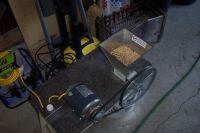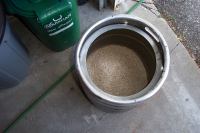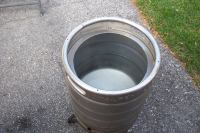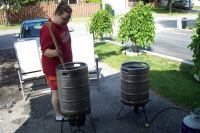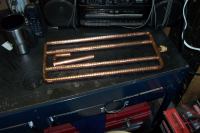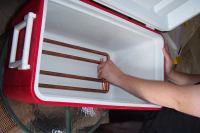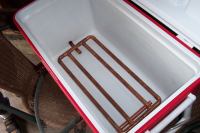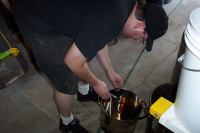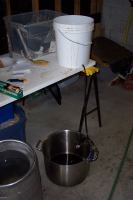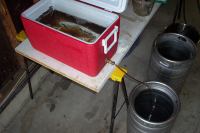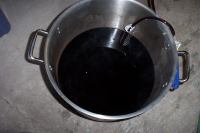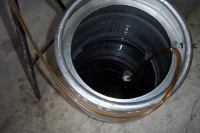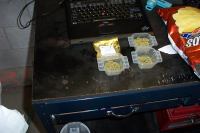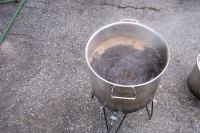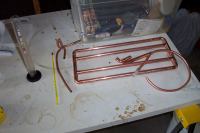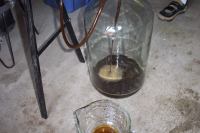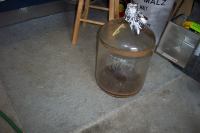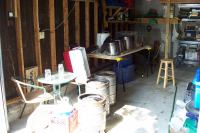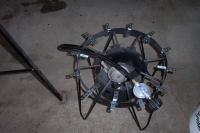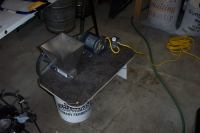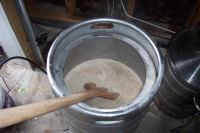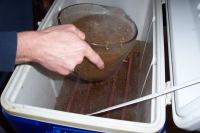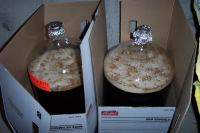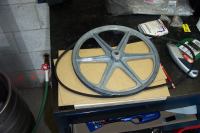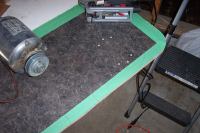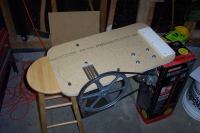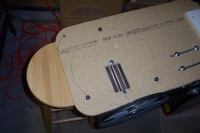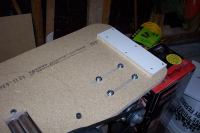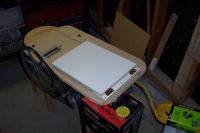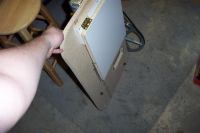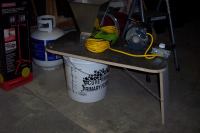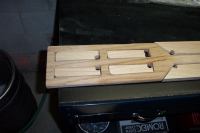bierblog: June 2006 Archives
June 24, 2006
wee heavy + coffee porter mayhem!
today was another brew day. the plan for today was two follow-on batches using the yeast cakes from the "single malt scotch" ale: an oaked wee heavy (our first time using oak) and eric's project, a clone of Hair of the Dog's Fred. unfortunately, eric is having more back troubles, and between that and scheduling issues he wasn't able to come out today. so i threw his half of the yeast cake in the fridge for later use, and decided to go ahead with the wee heavy. eric also recently graduated and has joined the "real world". i don't think he's enjoying the schedule as much as student life ;)
since none of the biergotter regulars were available, i asked taavi if he'd like to come out again for the brew day. that's when he let me know that he'd recently got engaged and asked if i'd consider making all the beer for his wedding. i congradulated him and said that it would be an interesting and fun project. since the wedding is scheduled for august of next year, we had lots of time to decide on recipes and do some trial batches. i think that the bulk of the beer will be something along the lines of our pale ale, but we'll probably also do a batch or two for those with more "educated" tastes. when i asked about what sort of things he likes to drink, the first thing he mentioned was mill street's coffee porter. as i love almost all things porter, including mill street's porter, and i've long been considering trying a coffee porter, i was definitely interested. i started with our sweet johnny porter and came up with what i'm currently calling java johnny porter. it's a fairly straight robust porter, but i'll be cold steeping some coffee and adding it at bottling time. delicious!
the day started around 9:00am. i went out to the garage to set things up for the brew day and found that almost everything was covered in a layer of dirt, shingle bits, and wood chips. we had our roof redone yesterday, and it appears that all kinds of crap rained down when they were stripping off the old shingles. maybe it's only really an issue since our roof was definitely past its prime. taavi arrived at about 9:30, which turned out to be perfect timing as i'd just finished cleanup and had started weighing out the grain for the two batches.
the other change for today was no more protein rests. so far we've been doing them with all of our all-grain batches, but as i've learned more i don't think it's necessary. these days malts are very well modified, so in general there's no need to do a protein rest. i tested this out on our last brew day, skipping this rest for the pale ale v2. it turned out just as good as the previous run and we had no problems with efficiency either.
our usual brew day procedure is heat up 1 quart of water per pound of grain to 130F, mix well, and when we're not at 122F we'd heat it to reach that point. this would rest for 30 minutes. then we'd boil 1/2 quart of water per pound of grain, add that and then heat it until the grain is at the desired temp for the saccarification rest (150F-160F) and rest there for an hour. with the last brew of the pale ale, i did the same thing, but without a rest between adding the 1 qt/lb at 130F and adding the 1/2 qt/lb at boiling. that worked out ok, but is kind of annoying. this time i decided to try out a feature in promash that i've never used before, the strike temp too. this thing is pretty cool. i stuck in the mash tun thermal mass (i used 0 as a first try), total grain weight, water/grain ratio or total water, the desired strike temp, and the current grain temp. i did this for the two batches and when i did the dough in both batches exactly hit their target temps for the sacc rest. this was much easier (and faster) than our usual procedure.
started both batches pretty much at the same time, with the sacc rest for the wee heavy starting about 15min before the porter. i wanted to run them pretty much in parallel to minimize time for the brew day, but then realized that the one thing i can't do in parallel is chilling, and with the extra 30min on the boil of hte wee heavy, i'd have them finsihing at almost the same time. however, that didn't account for differences in the time to sparge both of them. the smaller grain bill on the porter and the bucket tun made the grain bed set quickly and the sparge on this one was done quite fast. actually ended up with the porter reaching a boil 30min before the wee heavy, and with the extra boil time on the wee heavy it meant we ended up with an hour between when the two would finish. just enough time to chill the porter, transfer it into the fermenter, and get ready for the second batch.
when the yeast was pitched and everything was cleaned up it wasn't even 5:00pm yet. pretty good for two batches.
on with the photos!
the barley crusher tearing through some grain. man i love this thing. best brewing investment so far.
the wee heavy grain, waiting for dough in.
water for the wee heavy rising towards the target of 167F.
jenn came out to say hello and checked on the water for the porter.
exterior view of the new bucket tun, for use with "small" batches (under 15#).
interior view of the tun. the manifold is a ring of soft copper tubing with slits cut about every quarter inch, then a small piece of tubing joining it with one end of the hose barb. the other end of the hose barb goes out through a hole in the side of the bucket and has a hose attached for collecting sweet sweet wort. there's also a few pieces from the old cooler manifold, which finally died after the last batch. one piece raises it up off the bottom of the bucket, the other lifts it and helps push it away from the side, closer to the center of the bucket.
the new copper manifold for the cooler. the two pieces in the center are scraps that are used for positioning the manifold in the center of the tun and raised up off the bottom.
that's me positioning the new maifold in the cooler. the first piece of copper tubing is used to lift it off the bottom of the cooler and help keep the rubber stopper in place.
final position of the tun. there's an elbow and small piece of tubing on the upper left end to hold it away from the side and off the bottom. the outlet is actually hidden at the lower right end of the photo.
that's me again, this time checking on the vorlauf of the porter. already nice and clear!
collecting the sweet sweet wort for the porter.
and collection for the wee heavy.
close up view of the porter. note the adjustable wrench on the right hand side of the image. picked up this tip from one of the guys who sent us an ask biergotter message. richard dropped us a note and tim and i went out to visit one of his brew days. we sampled some of each other's beers and traded stories. when i first noticed him using an adjustable wrench to control the flow from his tun i thought it was a little odd, but then i tried it out and it's great. hose clamps never seem to stop in just the right spot, but wiht the adjustable wrench you can set it to exactly where you want.
close up on the wee heavy too. another adjustable wrench in use here too.
promash and lunch: sausages, munchos, and the resurrection of the edmund fitzgerald. damn this stuff is good!
hops ready for addition. on the left is the 15min and 0min fuggle additions for the porter (60min addition of northdown had already gone in), and on the right is the 90min northern brewer addition and 10min fuggle addition for the wee heavy.
the porter, happily boiling away.
the wee heavy, not quite boiling yet.
shinny copper manifolds!
the porter heading into the fermenter. taavi looks like a proud father with his first beer.
damn your eyes, porter!
the remains of the scotch ale. about a half gallon of beer and a whole lot of yeasty goodness.
the wee heavy heading into the fermenter.
post brew day carnage. 3 kegs in front, one of the two propane tanks, cooler tun, two burners and extra grain under the table, two 5gal pots and one 10gal pot, bucket tun, bin with all the odds and ends.
both batches in the fermenters. porter on the left and wee heavy on the right.
next up: rob and i will be brewing up 10 gallons of an arrogant bastard clone. chinooky goodness!
June 12, 2006
better late than never
couldn't decide what to call this entry, but since i've been procrastinating putting it up for over a week, this one seemed appropriate.
so june 3rd was another biergotter brew day. tim and eric came out to my place bright and early. the plan for the day was two 10 gallon batches. the first would be a rebrew of the pale ale that i brewed a few months ago, pale ale v2.
the second batch was an experiment that i've been considering for a while, a scotch ale using peat and smoked malts and using some oak, taking some of the character from my favourite single malt scotches and applying that to beer. since none of us has worked with smoked malts or oak before, we decided to simplify things a bit and save the oak for another batch. after a bit of research i came up with the recipe for v1 of the "single malt scotch" ale.
up in the toronto area (really, all of southwestern ontario) it's pretty hard to find any good hombrewing supplies. tons of wine shops, but no good beer shops. as a result, it usually means when one of us is in windsor we'll make a trip over to the detroit area for supplies.
after reading this post on beeradvocate about a place called "Adventures in Homebrewing" selling corny kegs for $13, i started looking for their website. sure enough, within a few minutes google had pointed me to the Adventures in Homebrewing website. poking around on their site i found that they had much more than just good deals on corny kegs (which are now $15, and still a good deal). I emailed them and got a quick, friendly reply from Jason. then eric emailed him to get a kegerator setup, and jason hooked him up too. i was initally planning to hit there for hardware and make another stop for ingredients, but i was able to find just about everything i could imagine at their shop, so i just went there.
with the recipes in hand, i made the trip over to detroit to check out a adventures. As Jason had told me, Matt was working when i arrived. he was just finishing up eric's order and was very helpful as i gathered up all of the stuff i needed. tim also decided to go with the same thing that eric was getting, so Matt worked on getting everything for his order. they were even nice enough to assemble the towers for us (and watching him do it, i'm glad: it looked like a pain in the ass).
so i'd be happy to recommend Adventures in Homebrewing to anyone in the detroit area looking for a LHBS, and also to anyone looking for a good place for mail order. can't beat the price of those kegs!
anyway, the brew day started off a bit rocky, with tim and eric getting a little lost and arriving a half hour late, but my newly-motorized barley crusher made up for that in no time. it took us all of 15 minutes to weigh out the grain for both batches and grind it all. sweet!
the rest of the brew day went fairly smoothly (other than somehow managing to forget to mashout the pale ale) and we even finished up earlier than usual. jan stopped by after he finished work and got to check out the end of the day.
we got to sample some neat beers too. jayc supplied us with a bottle of weyerbacher double simcoe ipa and decadence. we compared this with our dipa, dry hopped with simcoe. the decadence was interesting, and the double simcoe ipa was damn tasty. i should also thank jay for the homebrew too, since i finished off my stash a while ago and he hooked me up with some of his stash.
didn't take too many photos, but here they are.
my 'turkey fryer' burner. the outer ring is exactly the same size as the ring on the bottom of our keg kettles, so they don't fit properly on it. i added some brackets to create about a 3" border around the edge and allowing the kegs to sit on top happily. cost about $6 and worked great!
the motorized barley crusher, waiting for action...
...and running at full speed. eric's topping it up as it runs. tore through the 16# grain bill for the pale ale in record speed.
eric weighing out the grain for the scotch ale. look at the mess he's making! oh wait, i did that earlier...
tim, and the maiden voyage of his cooler tun. it's currently filled with the mash for the pale ale.
starting collection of the pale after finishing vorlauf.
i think this was mashing out on the scotch ale. definitely not mash out on the pale since we forgot to do that, and you just saw it being sparged.
tim starting to load his tun up with the mash for the scotch ale. you can see the nice copper manifold that he built for it. worked out pretty well. i've got one about 75% done for jay's cooler, and a soft copper coil for a smaller bucket tun. the old soft copper manifold from jay's cooler finally died after the ed fitz brew day and jayw has the bucket tun down in windsor for him to do some brewing. since he's a proud new daddy we're not sure how soon that'll happen :)
and then we jump ahead to 24 hours after pitching. that's the "single malt scotch" ale. a week later it's still got a nice head of krausen on top, which i expected as i know that the scottish strain is fairly slow. the current plan is to transfer it to secondary on june 24th, when eric and i will be brewing up 5 gallons each of a wee heavy and a hair of the dog fred clone, with each of them going onto one of the yeast cakes from the scottish. looks like jan will come back for the full brew day experience on that one. always good to get other people hooked!
and the pale ale. after 8 days in primary it had dropped from 1.045 down to 1.011, which is 74.86% attenuation and 4.47% abv. also saved the yeast cake for some future adventure.
June 7, 2006
motorizing the barley crusher
if you read my entry about raising the edmund fitzgerald, you know that i've recently purchased a shiny new barley crusher. well, long before i bought it i also had plans to motorize it.
as with all home-made homebrew gadgetry, my first stop is always Mike Dixon's webpage. can't say enough about Mike. he's always active and helpful in the homebrewing forum on beeradvocate, and his webpage has tons of useful info. a quick look down the page and you'll find a page detailing motorizing a malt mill and building a larger hopper for the grain, including a link to an article he wrote in HBD that tells you everything you need to know to motorize a mill, including all the math for getting the right RPM and selecting sheaves and belts. i'm basically just copying info from there, with the numbers changed to reflect the parts i used.
first order of business was a motor. this fall one of my neighbours was getting rid of their furnace, and one of the items that was sitting at the side of the road was a nice electric motor that i knew would work great if it was still functional. it also had a couple of sheaves, and i figured that at least the small one would be useful for my purposes. i stopped at the local hardware store, grabbed a dimmer switch, box, and an extension cord, wired it all up and plugged it in. as i slowly turned on the dimmer switch, the motor began to hum and sprang to life. free motor, excellent!
Grainger is a great resource for all the parts for this project (and lots more). on a recent trip to Minnesota i dropped in to one of their locations and picked up everything i needed for this project.
according to the website, the barleycrusher says it can do 500rpm. my motor is the typical 1725rpm and has a small adjustable sheave is 3.5" with 3.25" pitch diameter maximum and should go much smaller. so with 1725rpm motor and a max of 500rpm on the barleycrusher i know i'd need a sheave pitch diameter ratio of at least:
1725/500 = 3.45
so if we assume that my small sheave is 3.25" that means that the large sheave would need to be:
3.25" x 3.45 = 11.2125" pitch diameter or greater (with existing 3.25" wheel)
so checking out grainger i found a 12" sheave that looked like it'd work. figuring out the exact speed of the mill based on these two sheaves:
12"OD sheave has pitch diameter of 11.85". 1725rpm * 3.25"/11.85" = 473rpm
under 500rpm as expected. great! i also figured out that if i adjust the small sheave so it has a pitch diameter of 2.75" i'll drop the speed even further, to 400rpm. better to be safe, so i figured i'd go for this.
however, the 12" sheaves have an internal diameter of 1/2" and the barley crusher has a shaft that's 3/8". fortunately grainger also has bushings, and the 3/4" to 1/2" bushing would be perfect. the only tricky bit that i had to do was slightly modify the bushing. it's "C" shaped, but the opening wasn't wide enough for me to tighten up the bolt in the 12" sheave. i pulled out my trusty dremel and was able to trim the bushing, widening the opening enough that the bolt to fit through and allowing me to tighten it up on the shaft.
now, to figure out the size of belt i'd need:
center distance of shafts must be > 8"
C = (L - 1.57(D+d))/2
C = (L - 1.57(12+3.5))/2
C = (L - 24.335)/2
C = L/2 - 12.1675
40" length: C = 20 - 12.1675 = 7.8325" (too close)
50" length: C = 25 - 12.1675 = 12.835" (good)
so a 50" belt would be great. again, grainger sells a 50" v belt that would be perfect.
with that i had all the parts i'd need and set to motorizing the mill.
the large sheave and the belt. you can also just barely see the sheave inserted in the center of the sheave.
laying out the pieces and figuring out placement. when we replaced our kitchen countertop recently i saved the piece cut out for the sink. perfect for the base of the mill. another great idea from Mike.
after marking/drilling the placement for the new barley crusher base plate. there's two outer holes to anchor the mill down, and the four corner holes that were used to cut out the exit hole for the grain.
here you can see the barley crusher fitted in place with the sheave attached, and the slots made for anchoring the motor. there's lots of room to move the motor in case i end up switching to a different size belt or need to tighten/loosen it.
the motor, mill, and power all hooked up. now it needs something to sit on for general use.
after flipping over the entire setup i positioned and traced the outline of a bucket. i then took the three bucket gides from the original barley crusher baseplate and transferred them to this one to help hold the bucket in place.
two shots of the underside of the mill. you can see the outline and the position of the guides. i positioned the first one so that it'd also support the leg when closed (more on that below)
the other end of the baseplate. i screwed on a small piece of wood to raise up above the bolts that are holding the motor in place.
then i made a leg so that it'd sit level when the oposite end is resting on a bucket. it's hinged and attached to the piece shown above, and when closed like this the opposite end rests on one of the bucket guide pegs as mentioned above.
standing on its end. notice the chain i added to make sure the leg wouldn't get over-extended.
two shots of the finished motorized mill, one from each side.
so far the motorized version has been used for one brew day. it took us all of 15 minutes to weigh out the grain for the two batches (18# and 16#) and grind it all. that's pretty damn good when you consider that we'd normally be at this for a couple hours of manual grinding with the old corona mill (as seen here).
making a mash paddle
i've been searching for a good stainless steel mash paddle for a while now and not having any luck. i found a couple, but they were always far too small and not nearly strong enough to try and stir 30 pounds of grain when mashing. we previously tried plastic, but when we were pretty much bending it in half it made us nervous. for a while now i've been using a broom handle, which is definitely big enough and strong enough, but doesn't really stir a mash that well. so when i saw this post on beeradvocate about another homebrewer considering making his own mash paddle i was quite interested. a nice hardwood mash paddle would certainly do the job, and i could make it any size i liked.
there were a couple of links given in the thread on BA (this one showing a fairly simple design that's a bit smaller than i was thinking and this one [link to http://www.hopsdirect.com/spotlight/9903/ is dead, but still available courtesy of the wayback machine] that showed some larger and fancier designs and talked a bit about wood types). that pointed me in the right direction. a bit more searching found several more (1, 2, 3, and 4). so i had some good ideas.
i figured that buying a big piece of suitable wood would be expensive, but a quick trip over to my local lumber store and i had a 4'x6"x1" piece of red oak for just over $20. not bad at all!
i decided on a rough design and did a full-size drawing on paper, making a few adjustments until i thought i had what i wanted. (i'm going to add a printable PDF here eventually in case anyone would like to do the same. if you're interested, drop me an email and i can give you the measurements or something). Edit: here they are, just make sure you print them at the original size and don't use any scaling:
unfortunately, i didn't think to grab my camera until i was done making the paddle, but i still had the scrap pieces around so i took a few photos to give you the rough idea.
the whole thing, layed out as before i started cutting.
a closeup of the bottom end of the paddle. initially i made large holes at each corner. for the inner holes you can see that i tried to make two of them beside each other, but it was quite a pain in the ass, and really unnecessary. the large holes were not really necessary either. i made smaller 1/4" holes in the opposite corner of each section and it was enough to get my jigsaw in and around the corner.
the top end of the paddle, with a nice handle that makes it easy to control and a hole so that i can hang it up when not in use.
closeup of the finished bottom end of the paddle.
and the top.
the finished paddle hanging on the wall in my garage, waiting for the next brew day.
the basic procedure i used was to draw the design out on the wood, drill pilot holes in the corners (5/8" for the big ones, 1/4" for the small ones), then use a jigsaw with a blade designed for hardwood to cutout the four center pieces and the two sides. once i had the basic shape cut out i tried using my dremel to do some rough shaping and sanding. i found that the small tool size made it difficult to get a nice even finish to the edges, so i switched to a belt sander. the belt sander made quick work of rounding out all the edges, but didn't work very well in the corners. i went back to the dremel to clean up the edges and the parts where the beld sander couldn't reach (like the four inner holes). i used a foam sanding block to smooth everything out, then switched to a piece of find grit sandpaper to finish things off, concentrating on making sure the handle was nice and smooth.
we've used it for two brew days so far, and it's working wonderfully. i'm quite happy with it and have completely forgotten about my initial search for a stainless paddle.
© 2005 Bierg�tter Homebrew Club. Disclaimer.
Last Modified:
Saturday, 30-Jun-2018 08:44:54 MST
